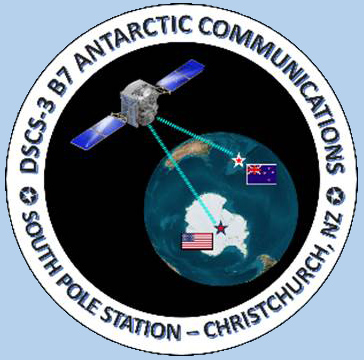|
Defense Satellite Communications System (DSCS)
The National Science Foundation (NSF) secured arrangements with the U.S. Strategic Command to access the Department of Defense's (DoD) Defense Satellite Communications System (DSCS) constellation of military satellite communications (MILSATCOM) satellites. This arrangement is similar to that obtained commercially via Intelsat General System and Airbus Space and Defense for access to the United Kingdom's Skynet MILSATCOM system. The NSF South Pole DSCS link currently uses the DSCS-3 B7 satellite - launched in 1995. It is maintained in a high inclination geosynchronous orbit, making it capable of providing limited daily coverage between South Pole Station and an NSF gateway teleport implemented at the International Antarctic Center in Christchurch, New Zealand. The Satellite is operated by the 3rd Space Operations Squadron (3SOPS) at Schriever Air Force Base in Colorado Springs, Colorado. NSF access is coordinated via the U.S. Strategic Command with direct assistance by the Army Forces Strategic Command (ARSTRAT). NSF is an approved MILSATCOM user, and is sponsored by the Office of the Secretary of Defense's Chief Information Officer's (CIO) Office. The satellite link was declared operational in early June 2016 as the successor system to the decommissioned service via the NSF GOES-3 satellite, which occurred later that month. Satellite Link Information
The system uses a VSAT (very small aperture terminal) designed by Global Satcom Technology, Inc.; it is identical to the Skynet MILSATCOM link. This provides a common systems architecture, operational management, and spare parts. The Christchurch terminal is located on the roof of the International Antarctic Center. International backhaul communications from the Christchurch terminal to the USAP wide area network hub in Denver is provided via a secure virtual private network (VPN) link via commercial Internet Service Providers. Planning is in progress for the conversion of the now inactive South Pole 9-meter terminal - previously used for GOES-3 L/S-band communications - into a more capable X-band DSCS terminal. The larger size of the antenna has the potential to provide higher data rates via the DSCS satellites. The existing 2.4 meter VSAT terminal will be repurposed as a DSCS terminal backup, and a prime terminal for the Skynet MILSATCOM link. |
DSCS Satellite



For USAP Participants |
For The Public |
For Researchers and EducatorsContact UsU.S. National Science FoundationOffice of Polar Programs Geosciences Directorate 2415 Eisenhower Avenue, Suite W7100 Alexandria, VA 22314 Sign up for the NSF Office of Polar Programs newsletter and events. Feedback Form |


